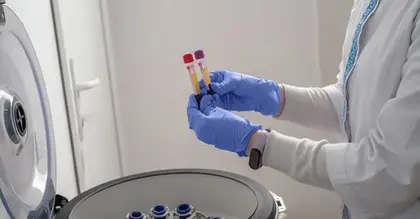
- Researchers say a new procedure that burns stomach lining may help decrease production of hunger hormone ghrelin.
- Ghrelin levels are typically higher in people with obesity and rise when they lose weight.
- There’s currently no pharmacologic way of reducing ghrelin.
A new endoscopic procedure that involves a type of controlled burning of the stomach lining could reduce production of a hormone that triggers hunger.
That’s according to a new study that details the possible new weight-loss treatment on the horizon with what researchers called an innovative endoscopic procedure that ablates (burns) the stomach lining to reduce production of ghrelin, a hormone that triggers hunger.
Researchers say that change could decrease appetite and produce significant weight loss.
The findings haven’t been published yet in a peer-reviewed journal, but the results of the method’s first-in-human trial is scheduled to be presented at Digestive Disease Week 2024 later this month.
The clinical trial lasted six months and involved 10 female subjects considered to have obesity.
The researchers said the trial resulted in a more than 7% loss of body weight and a reduction of more than 40% in fasting ghrelin levels.
The participants reported through a validated questionnaire that their hunger was diminished by more than a third.
The procedure also caused a 42% reduction in the subjects’ stomach capacity, according to a standard drink test.
“Obesity is chronic, lifelong disease that is predicted to affect nearly half of the U.S. population by 2030,” said Dr. Christopher McGowan, the lead author and a gastroenterologist and medical director of True You Weight Loss, a doctor-owned clinic based in North Carolina, in a statement. “Its effect on overall health, quality of life, and global healthcare costs is massive, and we need as many treatment options as possible.”
“This relatively brief, outpatient, non-surgical procedure can facilitate weight loss and significantly curb hunger, and it could be an additional option for patients who don’t want or aren’t eligible for anti-obesity medications, such as Wegovy and Ozempic, or bariatric surgery,” McGowan said.
The researchers said the procedure – an endoscopic mucosal ablation – targets ghrelin, which is the primary hunger hormone controlling appetite. It does so by altering the stomach lining, where the hormone is produced.
An endoscopist inserts fluid that protects underlying stomach tissues, then uses a tiny device to ablate – or burn – the mucosal lining of the stomach’s upper portion, known as the gastric fundus.
The feeling of hunger originates in the gastric fundus when the chamber empties, leading to increased production of ghrelin. As the gastric fundus fills with food, hunger subsides and ghrelin production dips. Mucosal ablation reduces the number of ghrelin-producing cells.
“Obesity and weight are very complex and regulated by multiple hormone pathways,” McGowan said. “This procedure alters one of these many pathways that make it difficult for people to lose weight and maintain weight loss.”
The scientists said ghrelin levels are typically higher in people with obesity and rise when they lose weight, making it difficult to maintain weight loss.
The only previous proven method of reducing ghrelin was to surgically remove, or bypass, the gastric fundus. The research team said there’s currently no pharmacologic way of reducing ghrelin. Anti-obesity medications, such as Wegovy and Ozempic, use a different hormonal pathway – GLP-1.
McGowan said if the procedure proves to be effective over longer time periods in larger trials, it could complement endoscopic sleeve gastrectomy, a non-surgical weight-loss procedure that reduces the size of the stomach. It could also potentially be offered as a one-time procedure complementing or replacing other treatments.
“This is just the beginning,” McGowan said. “The first question was whether we can endoscopically reduce hunger and ghrelin. The answer is: yes, we can.”
Dr. Mir Ali, a bariatric surgeon and medical director of MemorialCare Surgical Weight Loss Center at Orange Coast Medical Center in California who was not involved in the research, told Medical News Today it’s encouraging to see new procedures that may allow people not comfortable with current methods to still seek treatment for obesity.
“It’s minimally invasive and may attract people who are wary about surgery,” Ali said. “Endoscopic procedures have minimal down time compared to surgical intervention.”
However, Ali said, there are downsides as well.
“It’s comparable to other endoscopic procedures, such as gastroplication, already being done. These procedures are less effective in that there is typically less weight loss compared to surgery,” Ali said. “The endoscopic procedures are not as durable and there is significantly more weight gain compared to surgery down the road.”
“Finally, it is very difficult to get these types of procedures covered by insurance and results in a substantial cost to the patient,” he noted.
Dr. Steven Batash, a gastroenterologist at Batash Endoscopic Weight Loss in New York City who was not involved in the research, told Medical News Today that he has questions about the study.
“What was the exact number of patients that were studied with this ablation procedure and were there randomized controls done for comparison?” Batash asked. “Was the fundal ablation done alone or was it done in addition to the endoscopic sleeve gastroplasty, or was it done in addition to the endoscopic sleeve gastroplasty and GLP-1 agonists? If it was done in conjunction with the endoscopic sleeve gastroplasty and/or GLP-1 agonists, then the crucial question that needs to be addressed is what was responsible for the weight loss and decrease in appetite –the endoscopic sleeve gastroplasty or the fundal ablation?”
Batash said he also wonders if the hormone levels documented after the procedure at one month, three months, six months, or 12 months and was there a sustained decrease in the level of the hormone?
“It is important to note that with surgical bariatric procedures, the level of ghrelin is reduced because more than 50 percent of the stomach is resected. Yet these levels eventually reconstitute themselves within 9 to 12 months,” he explained.
Batash added that the ablation procedure works by burning or damaging the lining of the stomach and the stomach lining will reconstitute itself within a month, thereby starting again the enhanced production of the ghrelin hormone.
“It would therefore be expected that this effect of the decrease of ghrelin would be very short-lived,” Batash said. “What are the real risks of the ablation procedure? The fundus of the stomach is the thinnest part of the stomach. It has a rich vasculature. It abuts on many vital adjacent organs. Because of this reality, during a standard endoscopic sleeve gastroplasty, the fundus part of the stomach is avoided.
“What then are the real risks of fundal ablation of bleeding, perforation, and damage to adjacent organs?” he asked.





